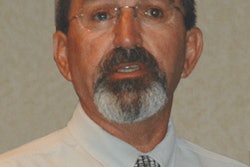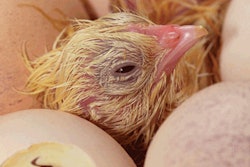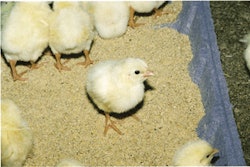
"Things are changing so rapidly, surely we are pushing the fast forward button," said Dr. Pierce Lyons, president Alltech. "We have an incredible challenge. Feed a hungry world, provide energy and make picky consumers happy at the same time." Lyons spoke at the Alltech International Symposium, and discussed the challenges that animal agriculture and the feed industry will face in the future as governments promote the production of biofuels. Information was presented on how poultry companies can cope with these challenges by examining things as varied as finished product marketing, breeder feeding regimes and export markets.
A Step Forward For Cellulosic Ethanol
President Bush has declared a "war on our addiction to oil," Lyons said, and, "The war on oil is an indirect war on the feed industry." President Bush's proposal that we produce 35 billion gallons of renewable and alternative fuels by 2017 would require 300 million tons of corn annually, if all of the fuel was ethanol produced from corn, and this would use the entire corn crop at current production levels.
In addition to the rising demand for corn to produce ethanol, Lyons said that there will be greater demand for grains to feed animals. "As India and China develop larger middle classes, we will need more grain to feed animals to produce the meat that they will want to eat," Lyons said. "Cellulose will be the redemption."
Solid state fermentation (SSF) breaks down fiber, this is the same process that mold uses to breakdown bread in a dry state. Alltech built an SSF plant at Serdan Mexico in 1999. "SSF is the key to getting energy from cellulose," Lyons said. "To win the war on our addiction to oil it will take the best minds in science. It won't be won by tanks and guns, but it will be won by fungi and enzymes."
Alltech announced plans to build a "community biorefinery" with some SSF capabilities in the USA in the near future. Even cellulosic ethanol production, ethanol will not be the answer to all of our energy needs. Lyons said that the USA produces 1 billion tons of waste cellulose annually, but even if all of this was converted to ethanol this would only replace half of our current gasoline usage.
Bigger Roosters Make Bigger Broilers
It is a common industry practice to restrict feed on broiler breeder males to keep them from getting too heavy. Dr. John Brake, professor, poultry science, North Carolina State University, said that his research has shown that this feed restriction means that the largest males are being underfed. Underfed males are less fertile and engage in less mating behavior. Ideally, the largest males would fertilize as many eggs as possible, because these offspring would be larger at market age. But, by underfeeding the largest males, the industry is not realizing the full genetic potential of today's faster growing breeds.
"Current breeder standards call for weights that are too low," he said. Roosters and hens need to be allowed to be bigger so that they will stay fertile and produce the biggest broilers. This has nothing to do with egg size, it has to do with keeping bigger roosters producing semen and mating. "When fertility in the flock goes down, the biggest males are not mating," Brake said. "If you control body weight of the males in the breeder house, the big birds are under fed. You have to feed the big birds and maybe the big pullets to get big broilers."
Given the need to do some level of feed restriction to keep smaller birds from getting fat, Brake suggested feeding vitamins C and E along with selenium supplements to help offset some of the impact of underfeeding the large roosters. He said that you can't always go by the book when managing breeders. "Remember to listen to the chickens, they don't read the manuals," Brake said.
Canadian Make Over
The rise of the Canadian dollar versus the U.S. greenback from the low $0.60s in 2000 to over $0.90 today forced Maple Leaf Foods, Inc., to make a drastic change. Maple Leaf was a commodity pork and feed company, according to Annalisa King, senior vice resident, transformation, Maple Leaf Foods, Inc. King said that the rising Canadian dollar hurt exports and NAFTA increased competition for Maple Leaf domestically.
Maple Leaf looked at its competitive situation and decided that it couldn't cost-cut its way to competitive advantage. The company has sales of $6.5 billion Canadian, and it has 24,000 employees working in 120 facilities around the world. Maple Leaf decided to value-add its way to competitive advantage instead.
Maple Leaf now only produces feed for its own hogs and only raises hogs for its own plants. The company tries to further process as much meat a possible, but it does sell some cuts on the commodity markets. Maple Leaf recently sold its feed and animal nutrition businesses to Nutreco.
King said, "Being the low cost producer did not fit with the company's culture. You need to be realistic about company goals. You need to have humility about the need for change and have the fortitude to stick it out." Maple Leaf has spent over $500 million in continuous brand marketing. King said, "Advertising never gets cut in bad years. Familiarity and emotional attachment are huge."
Companies that are successful innovators share some common traits, according to King. "You need to be risk tolerant, one in five packaged goods fails. Investments of $1 million to $5 million are common to get a product off the ground." Companies need a continuous flow of ideas and a process for evaluating and developing these ideas. "You need to create a culture of innovation," she said.
Maple Leaf is building a Food Center of Excellence which will open in 2008 in Toronto. King said that it will be a think tank for product developers, nutritionists and chefs. "Passionate people, passionate about food," King said.
Competition Heats Up In EU
Emma Cardy-Brown, Rabobank, food and agribusiness research and advisory, discussed the restructuring of the European animal production market. Cardy-Brown said that the obvious trend is consolidation, but all of Europe is not following the same model. In Northwest Europe, there is a trend away from vertical integration and there is more of a focus on core competence. For example, a company would focus on just processing or just live production.
In Eastern Europe, the trend is to more vertical integration, because it is harder to find reliable partners at other steps in the chain. Poultry production is way up in the 12 new members of European Union (EU)-27, up 40 percent in the last 10 years, Cardy-Brown reported. She sees the EU-15 countries importing a greater percentage of their meat and poultry products in the future.
Biofuels take energy out of the food chain. She said that rapeseed is being used to make biodiesel in Europe. She suggests that poultry companies develop partnerships with biofuels companies to increase the quality of the byproduct protein meals.


















